7 Things to Make with Pineapple Sage
Pineapple sage is more than just another pretty pollinator plant for your garden – it’s rich in antioxidants & also used as a traditional herbal remedy!
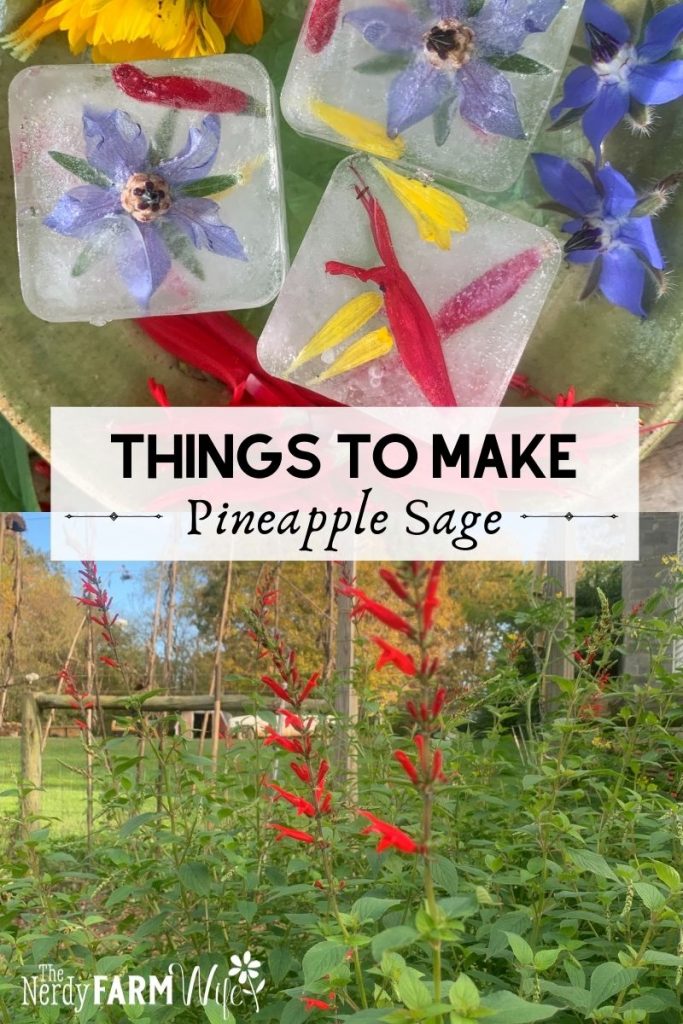
Health Benefits of Pineapple Sage
Pineapple Sage (Salvia elegans) is “widely used in traditional medicine, particularly in the form of infusions or decoctions, to… lower blood pressure and combat central nervous system disorders for anxiety and insomnia.”
Today’s science shows that hydroalcoholic extracts of pineapple sage have been shown to exhibit antihypertensive, antidepressant, and anxiolytic (anti-anxiety) effects and it may even help cognitive function.
It’s also rich in antioxidants and may impact key enzymes related to obesity and diabetes.
I was especially interested to learn that it’s rich in caffeic acid (a powerful antioxidant and anti-inflammatory which is great for your skin), so it would be fun to play with pineapple sage skin care recipes too! (That’s on my to-do list!)
All that, plus its pretty ruby red flowers attract all sorts of bees and pollinators to your garden. ❤
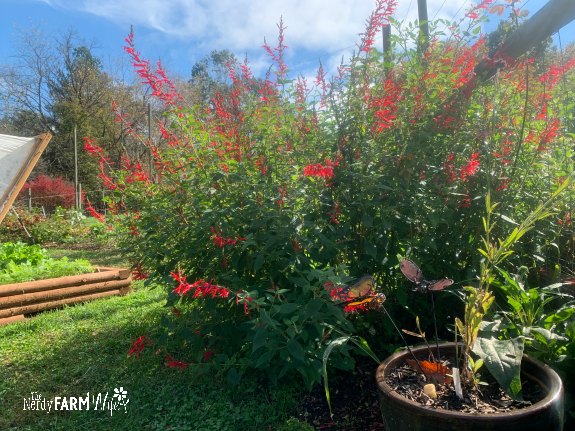
Pinapple sage is hardy in zones 8 to 11, but in the area I live (garden zone 7), pineapple sage grows slowly all summer, then bursts into bloom just a few weeks before the first frost, which for our area happens towards the middle or end of October.
That only gives me a short time to enjoy the flowers, though I do extend its season for a couple of extra weeks by tossing a heavy blanket over the plant to protect it from the first few light frosts.
How does pineapple sage taste?
The flowers remind me a lot of honeysuckle. You can pinch off the bottom bit of each one and suck out a drop of nectar that is yummy! The flowers don’t have a lot of taste other than the nectar though.
The fresh leaves smell wonderfully of pineapple, but when you eat one – it’s more of a leafy herby taste and not really so pineapple-y. The scent when you rub the leaves is the main thing that makes you instantly think – Pineapple!
Now that you know more about its awesome potential, here are 7 creative ways to use your pineapple sage plant.

1. Pineapple Sage Flower Vinegar
This beautiful jewel-toned flower vinegar can be used as:
- Hair Rinse – dilute with water before using
- Salad Dressings & Marinades – try using in place of balsamic or red wine vinegar
- Vinegar Bath – for tired, achy muscles
- Fruit Dip – we like 3 tbsp vinegar, 3 tbsp honey, 1 cup plain yogurt (adjust honey and vinegar amounts up or down to taste)
- Chigger Bites – vinegar is one of the best remedies I’ve found for those pesky critters that leave you itching for days
To make it:
Fill a jar about 1/3 way with fresh pineapple sage flowers. Cover with apple cider vinegar and cap with a plastic lid. (Vinegar will corrode metal lids over time.) Tuck away on a shelf or cabinet, shaking occasionally. The vinegar should start turning color within a week or so. Infuse for about 2 or 3 weeks, then strain. Store the strained vinegar in your fridge for 3 to 4 months.
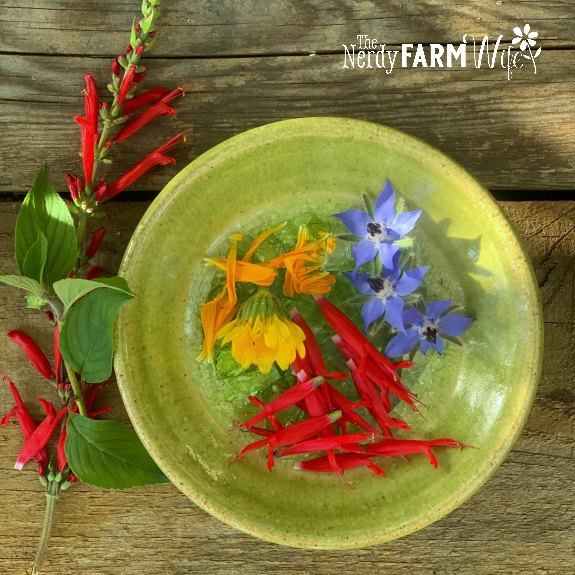
2. Use as a Creative Salad or Drink Garnish
Sprinkle pineapple sage flowers along with other edible flowers (borage, calendula, violet, forsythia, etc) over a veggie or fruit salad to add a pop of color.
You can also tuck flowering stems into pineapple drinks or lemonade.
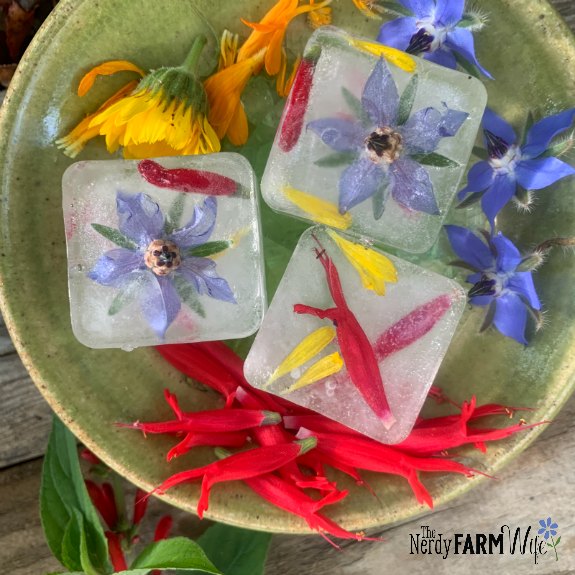
3. Edible Flower Ice Cubes
Pineapple sage adds a gorgeous pop of color in floral ice cubes. Here, they’re shown with fresh borage and calendula flowers.
Instead of water, another idea is to freeze the cubes with pineapple juice or lemonade.
Drop into drinks to add a pretty color and taste!
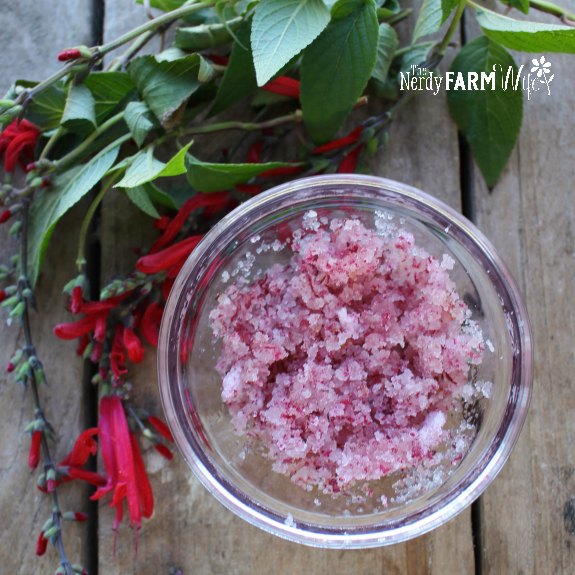
4. Pineapple Sage Flower Scrub
This pretty scrub requires just 3 ingredients:
- pineapple sage flowers
- granulated cane sugar
- your favorite carrier oil (sweet almond, rice bran, sunflower, etc)
Learn how to make it in my article:
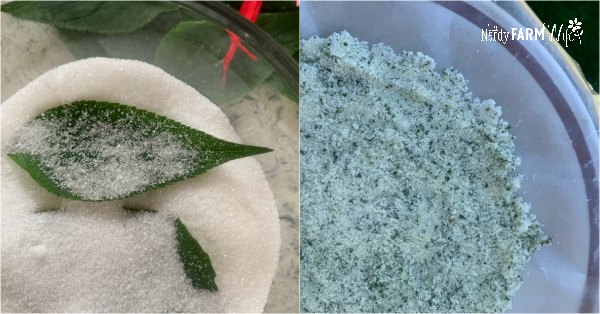
5. Flavored Sugar (2 Ways)
Pineapple sage flavored sugar is a subtle sweet treat to add to your tea, or to sprinkle over toast.
One ways to make it is to layer fresh pineapple sage leaves in sugar. Cover lightly and allow the leaves to infuse into the sugar for a week or two. After that time, brush through the sugar to retrieve the now-dry leaves. There may be some little clumps of sugar to break up with a fork or a mini food processor.
The second method involves blending leaves with sugar, just as you would for the pineapple sage sugar scrub above (only using leaves instead of flowers.) Air dry overnight, then grind again to a smooth texture. This gives a bit of a stronger flavor, but be aware that the pretty green color fades down to a brown-green over time.
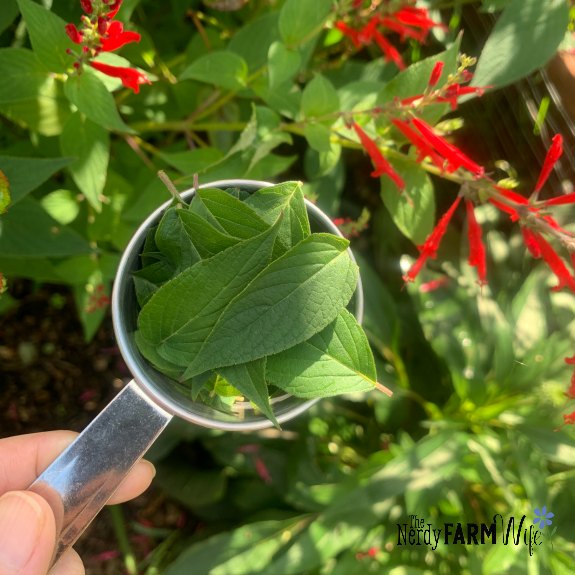
6. Pineapple Sage Tea
Tea is super easy to make with the fresh leaves. It may be helpful to sip on when you’re feeling stressed and anxious.
To make, just pick about 1/4 cup of leaves (packed), bring inside, and pour 1 3/4 cups of boiling water over them.
Cover the steeping container with a saucer to keep the aromatic vapors in, and steep for around 20 minutes, or to taste.
Sweeten with honey, if you’d like.
You can also use this to make iced tea. Just cool and pour over ice cubes. (Use the pretty edible flower ice cubes from above!)
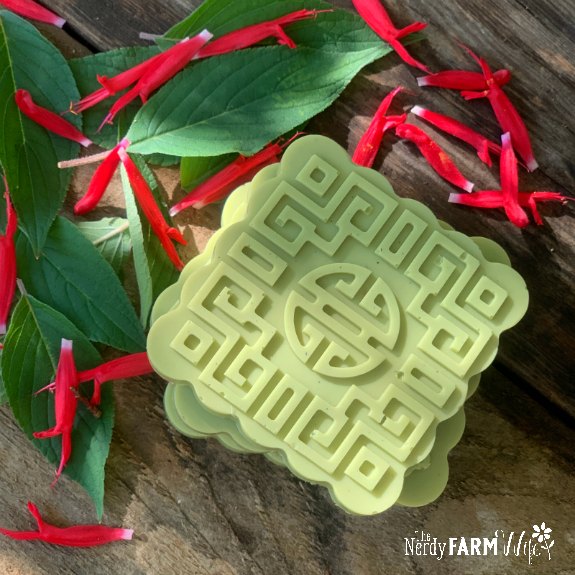
7. Melt & Pour Soap
In my experiments so far, pineapple sage doesn’t keep its color in cold process soap, but the leaves make a beautiful green when infused into melt and pour soap base.
(The flowers didn’t keep their color when infused in melt and pour either – only the leaves.)
It starts off a bright green, then will mellow to the softer green shown. The soaps in the photo are about 3 weeks old and made with SFIC shea butter base.
Ingredients:
1/4 cup fresh pineapple sage leaves
1 tsp (5 ml) water
8 oz (227 g) white soap base, cut into 1″ cubes
optional: 2 grams (abt 1/2 tsp) essential oil of your choice
Rubbing alcohol, for spritzing
Soap mold used: YGEOMER 2pcs Soap Mold, 6 Cavity Round and Square Silicone Mooncake Cake Chocolate Mold (find it in my Amazon storefront)
Directions to Make:
In a heatproof jar or container, combine the pineapple sage leaves, water, and soap base. If you’d like, microwave it about 20 seconds to jump start the infusing process.
Next, cover the jar loosely with a canning lid or small heatproof saucer. Place the jar in a saucepan containing a few inches (at least 5 cm) of water, forming a makeshift double boiler.
Heat over low to medium-low heat for 20 to 40 minutes, stirring occasionally, until the soap takes on a pretty green color.
If the soap isn’t turning as green as you’d like, try adding extra chopped leaves and infuse a little longer.
Remove the container from the heat, stir in essential oil if using, and strain the hot soap through a fine mesh sieve into your soap mold.
Work quickly, because the soap will start to harden once removed from heat.
A few more ideas…
I’ve also used pineapple sage to infuse pineapple juice before turning it into sorbet, or you could use the infused juice in a smoothie.
These are just a few ideas to get you started – have fun experimenting and learning about your pineapple sage plant!
(And if you don’t have one yet, think about adding it to your garden next year.) ?


What does pineapple sage taste like? Does it actually tasted pineapple-y? You always post about the most interesting herbs!
Hi Brandy – that’s such a great question! I’ll add my answer to the post too; that will make a great addition – thanks!! :)
The flowers remind me a lot of honeysuckle. You can pinch off the bottom bit of each one and suck out a drop of nectar that is yummy! The flowers don’t have a lot of taste other than the nectar though.
The fresh leaves smell wonderfully of pineapple, but when you eat one – it’s more of a leafy herby taste and not really so pineapple-y.
The scent when you rub the leaves is the main thing that makes you instantly think – Pineapple!
Wonderful, I’m looking for more herbs for my garden and it’s the second month of Spring in the Southern hemisphere so I’ll be on the lookout for Pineapple Sage to plant near the standard Sage in the garden. Thank you!
Hi Robyn! How wonderful to be enjoying the Spring season! I hope you’re able to find some pineapple sage! :)
What is a good source for Pineapple Sage? Can it be rooted in H2O? I live in zone 7 too! Love love the red flowers. Looks like it gets very large.
Hi Susan! I buy pineapple sage plants from my local garden centers or nurseries. I’ve seen them at Lowes, Home Depot & a few smaller nurseries – I believe Bonnie Plants sells them, if your local garden center carries that plant brand. From what I understand, pineapple sage does best propagated from cuttings rather than seeds. (I have a few sprigs in water now, just to see how they do.) It gets a nice size for sure and stays green all the way up until September(ish), when it finally blooms. Such a wonderful plant – I hope you’re able to find some to grow next year! :)
where can you buy pineapple sage?
Hi Jody! I’ve bought them at Lowes, Home Depot & a few smaller nurseries. Another idea is to look for places that carries Bonnie Plants.
I hope you’re able to find a plant to enjoy too! :)
Hi every one, I have one year experience with pineapple sage in a big plant pot. My wife bought it from a Wal-Mart nursery. Last summer I plucked all the large leave off the plant and oven dried them at 200 on parchment paper for 2 hours and put in a gallon jar for later uses. I tried a pineapple sage smoothie recipe once, it was good. I cut about 8–12″ stems from the mother plant and rooted all 8 in a big glass jar successfully in a few weeks and started another plant pot of them. I had flowers on mine from Aug all the way to the end of Oct in NW Oregon zone 8. There is lots of benefits for our bodies with this herb. I also love the smell of this plant and how it attracts humming birds and bees all summer and fall. I cut mine down to a inch and put straw over them in the plant pot for this winter, next spring in May they should start growing again. In the mean time I have dried leaves to enjoy as tea for the winter months.
Hi Jeffery, Thank you so much for sharing about your pineapple sage experience! That’s wonderful to hear too that they can be successfully rooted! :)
I dried the flowers last summer and added them to an herbal tea mixture. It sweetened the tea!
That sounds so lovely! ❤
I haven’t ever herd of pineapple sage before. Saw it at a local plant place. Love to try new things. I roasted a whole chicken with a compound butter using the leaves,I don’t have flowers yet. Stuffed it underneath the skin and rubbed on top. It was the best roast chicken I have ever made. It was light and tangy.
Hi Michelle, That sounds wonderful! Thank you for sharing! ❤
How do you make perfume with pineapple sage? Thank you!
Hi Christina, What a great question! I haven’t ever tried or researched that, so I’m not sure if it’s something that can be made or not, but I bet it would be wonderful if so!
If you find out how, or discover more information, I’d love to hear about it! :)
I was wondering if I could make an extract by muddling a jar of leaves in Everclear (190 proof) for a few weeks? I figured then I could strain the leaves, dry them, and add them to a blend of dried jasmine flowers, lavender flowers, rosemary nettles, and chamomile flowers. I was thinking that would make a wonderful calming tea. Then again I’m not sure on how to then use the extract?
Hi Machelle! You could definitely make an extract (tincture) that way, but if you want to use the leaves in tea, then I would just dry the leaves and use them directly in tea.
The Everclear will pull out so much of the goodies from the leaves, so they’ll likely be all spent by the time the extract is done.
I usually mix a couple of drops of tincture with a spoonful of honey to take. Some people like to put a few drops in tea, or you could even put a few drops in your favorite beverage. :)
Hi!
My first time working alongside pineapple sage and I am so excited to learn more. Making a tea now! I am wondering if you ever experimented using it with skincare things?
Hi Mae! I still haven’t gotten around to experimenting with it in skincare recipes yet, but I was thinking of starting with glycerites and infusing them into lotions & creams.
You could make a glycerite with pineapple sage, like I did for peach flowers:
https://thenerdyfarmwife.com/peach-flower-glycerite-face-cream/
Can you chew the leaves?
Hi Malinda, You sure can! I personally find they have kind of a tougher texture that’s not super pleasing to chew on, but it’s safe to do so – so you could give one a taste & see what you think! :)
I made a baked pineapple and goat cheddar cheese casserole with the pineapple sage leaves. I couldn’t really taste the sage, but now I know I got some great antioxidants.
Hi Diane, That sounds so delicious! Thanks for sharing such a great idea!
I live in zone 6 and I planted the pineapple sage and it is growing like crazy. Should I dig it up before frost and put it in a pot or just cut it back late fall and put lots of mulch over it and hope it comes back in the spring?
Hi Richonda! You could definitely try potting it up and bringing it in for the winter.
Alternatively, we’ve rooted cuttings from an vigorously growing plant & brought them in to grow over winter before & that can give you a jump start on planting new starts next spring.
You can try mulching this year’s pineapple sage heavily, but that’s dicey for us, even here in zone 7a, so not sure how it will do in zone 6.
This year one of my pineapple sages planted in a sheltered spot next to my porch did come back, but most often they don’t even with a good mulching.
I’m in 5b and I cut mine down and cover it. It’s survived two winters. I planted it next to the house foundation on the southwest side.
Hi Thom, Thanks for sharing! That’s wonderful to hear and great tips about planting it on the southwest side and covering it. Thanks!
The only thing I can add is about drying the leaves. It is really simple, I have a air cool refrigerator, I’m sure all of you do, now. Anyway, if you want to keep that lovely green color in the pineapple sage leaves, try drying them in the refrigerator. I have one sheaf I used for my oregano, Rosemary, sage, and yes, pineapple sage. I keep the lovely green to all of them! It is so easy to dry all my pants in there. It don’t take to long to get them dry, either. Then used a blender, or food processor to grind them up to your liking. With that being said, enjoyed your herbs, anytime during the year! 🫠
Hey there. I am actually going to begin working with my pineapple sage tomorrow to prepare some of these amazing ideas. My question is this: what is the best way to dry the leaves… if one doesn’t have a dehydrator. What is the best way to store it. I would love to use it in every way possible.
Hi Julie! I often just air dry the leaves on paper towels or a clean dish towel.
Separate each leaf from the stem and arrange them in a single layer. Every day or two, flip the leaves over to help them more evenly dry.
You can store dried leaves and flowers in brown paper lunch bags, or in glass jars out of sunlight and heat.
I have an article about drying herbs & flowers that might be helpful too: :)
https://thenerdyfarmwife.com/how-to-harvest-dry-flowers-herbs-from-garden/